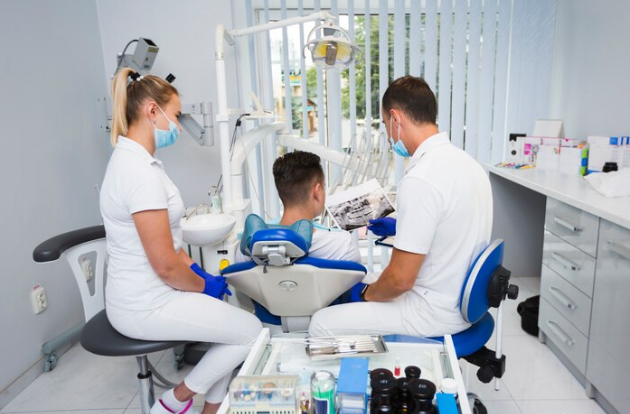Dental cavities are a common oral health problem that, if left untreated, can lead to significant discomfort and eventual tooth loss. Treating cavities typically involves removing decay and placing fillings. Many patients often ask, “how much does it cost to fix a cavity?” The answer can vary widely and is influenced by several factors, including the severity of the decay, the type of filling used, and the dentist’s experience.
What Are The Typical Costs Associated With Dental Cavity Fillings?
The cost of dental fillings primarily depends on the filling material used and the complexity of the cavity. Generally, cavity fillings can range from $50 to $300 per tooth for silver amalgam fillings, which are often the least expensive.
Composite resin fillings, which are more aesthetically pleasing as they match the natural color of teeth, typically cost between $90 and $450 per tooth. More durable and aesthetically pleasing materials like porcelain and gold can cost significantly more, potentially reaching up to $2,500 per tooth.
The choice of filling material affects the appearance and durability of the filling and also impacts the overall treatment cost. Composite resins, while more expensive than amalgam, are preferred for their natural appearance, especially for fillings in visible areas of the mouth.
Are There Any Factors That Can Influence The Price Of Cavity Fillings?
Several factors can affect the price of dental cavity fillings. The size and location of the cavity play crucial roles; larger cavities require more material and more complex procedures, thereby increasing the cost. Additionally, cavities in hard-to-reach areas or teeth that perform significant chewing functions, like molars, can be more expensive.
The dentist’s experience and geographic location also influence the cost. Dentists with extensive experience or those in urban centers often charge more due to higher overhead costs and market conditions. Furthermore, the local cost of living can affect dental service prices, making fillings more expensive in some regions compared to others.
Are There Alternatives To Traditional Cavity Fillings That May Be More Cost-effective?
In exploring cost-effective treatments for cavities, it’s essential to consider both the short-term and long-term costs. Traditional fillings, while effective, are only one of the options. Alternative treatments such as dental sealants, fluoride treatments, and newer technologies like glass ionomer fillings offer different price points and longevity.
Dental sealants are preventive measures that can be applied to the chewing surfaces of the back teeth, where decay most often starts. While not a filling, sealants can prevent cavities from forming and are generally cheaper than fillings. Fluoride treatments can also help restore enamel and prevent decay at a lower cost than fillings.
Glass ionomer fillings are another alternative that might be more cost-effective, especially for children or below-the-gum line applications. These fillings release fluoride over time, helping to prevent further decay. However, they are less durable than composite resin and amalgam fillings and might need to be replaced more frequently.
How Does Dental Insurance Coverage Impact Out-of-pocket Expenses For Cavity Fillings?
Dental insurance can significantly reduce out-of-pocket expenses for cavity fillings. Most insurance plans cover a portion of the cost of basic dental procedures, including fillings. The coverage typically ranges from 50% to 80% of the treatment cost, depending on the type of dental plan and the filling material used. However, many insurance plans have a maximum annual limit, which can affect how much of the filling cost will be covered in a given year.
Patients need to understand their dental insurance benefits and limitations. Some plans may not cover certain fillings, such as composite resins in back teeth, or may only cover the cost of an amalgam filling, requiring the patient to pay the difference for a more expensive composite filling.
In conclusion, while the expense of treating cavities can vary, understanding these costs and the factors influencing them can help individuals make informed decisions about their oral health care. Considering alternatives and the role of dental insurance can also help manage these expenses effectively, ensuring that dental care remains accessible and affordable.
Why Choose Gentle Touch Family Dentistry for Your Cavity Fillings
At Gentle Touch Family Dentistry, we understand the stress and uncertainty that can accompany the need for dental treatments, especially when it comes to managing cavities. Our practice offers personalized, compassionate care that makes dental health accessible and comfortable for all family members. We are your best choice for managing and treating dental cavities for several reasons.
Expertise and Precision: The dental professionals in our team possess exceptional expertise and contribute many years of experience to our clinic. Our dental practice utilizes cutting-edge dental equipment and advanced techniques to ensure that every filling is performed with utmost precision, resulting in both long-lasting durability and pleasing cosmetic results. Whether you need a standard amalgam filling or a more discreet composite resin, our dentists meticulously match the treatment to your needs.
Transparent Pricing: At Gentle Touch Family Dentistry, we believe in transparency when it comes to costs. Our cavity fillings range from $150 to $600, depending on the material and complexity of the procedure. We provide detailed breakdowns of all costs before any treatment, ensuring there are no surprises and helping you make informed decisions about your oral health.
Comfortable and Welcoming Environment: We take great pride in creating an atmosphere where our patients feel relaxed and cared for. Walking into our clinic, you’ll notice that your comfort is our priority. Our offices are designed to feel like a calm oasis, with comfortable seating, soothing decor, and a friendly staff always ready to help.
Flexible Scheduling and Insurance Handling: We understand that our patients have busy lives. That’s why we offer flexible scheduling options to accommodate your timetable. Additionally, our knowledgeable staff will help you navigate the complexities of insurance coverage and claims to maximize your benefits without hassle.
Frequently Asked Questions About Cavity Fillings
Q: How long does a cavity filling take?
A: A typical cavity-filling procedure at Gentle Touch Family Dentistry takes about an hour. This includes time for the preparation, the filling itself, and any necessary aftercare instructions.
Q: How often should I replace my fillings?
A: The longevity of a filling fully depends on the material used and of course, your oral hygiene habits. Amalgam fillings can or may last up to 15 years, while composite fillings might need replacement after 5 to 10 years. Regular check-ups ensure that any wear and tear is caught early.
Q: Are cavity fillings painful?
A: We strive to make all procedures as pain-free as possible. Local anesthesia is used to numb the area, ensuring you feel no pain during filling. Post-procedure discomfort, if any, is usually mild and can be managed with over-the-counter pain relief.
Q: What should I do if my filling falls out?
A: If your filling falls out, contact us immediately to avoid further damage to your tooth. We will schedule a prompt appointment to address the issue and provide a solution.
Ready to Restore Your Smile?
If you’re dealing with a cavity or suspect you might have one, don’t wait for the problem to worsen. Wondering how much does it cost to fix a cavity? Contact Gentle Touch Family Dentistry today. Our expert team is ready to restore your smile and help you maintain optimal oral health. Call us or visit our website to schedule your appointment.
Book Your Appointment at Gentle Touch Family Dentistry Today!
At Gentle Touch Family Dentistry, we’re committed to providing you with high-quality, compassionate care. Let us help you achieve a healthy, beautiful smile with minimal stress and maximum satisfaction. Call us now or fill out our online appointment form.



